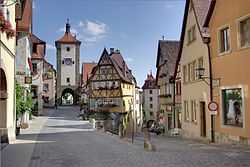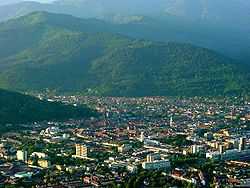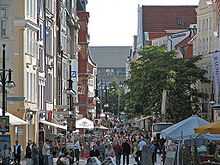|
|
| |
|
| Netherlands |
|
9.96 M |
| United States |
|
4.29 M |
| Switzerland |
|
3.86 M |
| United Kingdom |
|
3.70 M |
| Italy |
|
3.10 M |
| Austria |
|
2.57 M |
| Belgium |
|
2.54 M |
| France |
|
2.51 M |
| other |
|
22.29 M |
| Overnight stays in 2009 by country of origin[1][2] |
Germany is the seventh most visited country in the world,[3] with a total of 407.26 million overnights during 2012.[4] This number includes 68.83 million nights by foreign visitors, the majority of foreign tourists in 2009 coming from the Netherlands, the United States and Switzerland (see table). Additionally, more than 30% of Germans spend their holiday in their own country.
According to Travel and Tourism Competitiveness Reports, Germany is rated as one of the safest travel destinations worldwide.
The official body for tourism in Germany is the German National Tourist Board (GNTB), represented worldwide by National Tourist Offices in 29 countries. Surveys by the GNTB include perceptions and reasons for holidaying in Germany, which are as follows: culture (75%), outdoors/countryside (59%), cities (59%), cleanliness (47%), security (41%), modernity (36%), good hotels (35%), good gastronomy/cuisine (34%), good accessibility (30%), cosmopolitanism/hospitality (27%), good shopping opportunities (21%), exciting nightlife (17%) and good price/performance ratio (10%) (multiple answers were possible).
In 2012, over 30.4 million international tourists arrived in Germany, bringing over US$38 billion in international tourism receipts to the country.[5] Domestic and international travel and tourism combined directly contribute over EUR43.2 billion to German GDP. Including indirect and induced impacts, the industry contributes 4.5% of German GDP and supports 2 million jobs (4.8% of total employment).[6]
History
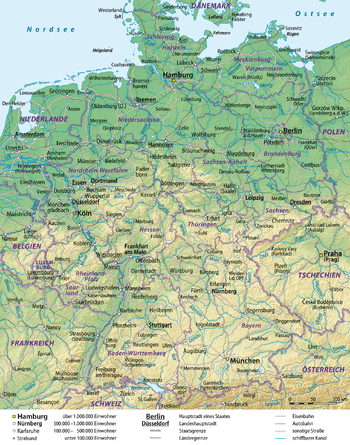
physical map
The history of tourism in Germany goes back to cities and landscapes being visited for education and recreation. From the late 18th century onwards, cities like Dresden, Munich, Weimar and Berlin were major stops on a European Grand tour.
Spas and Seaside resorts on the North and Baltic Sea (e.g. Rugia and Usedom islands, Heiligendamm, Norderney and Sylt islands) particularly developed during the 19th and early 20th century, when major train routes were built to connect the seaside spas to urban centers. An extense bathing and recreation industry materialized in Germany around 1900. At rivers and close to natural landscapes (along the Middle Rhine valley and in Saxon Switzerland for example) many health spas, hotels and recreational facilities were established since the 19th century.
Since the end of World War II tourism has expanded greatly, as many tourists visit Germany to experience a sense of European history and the diverse German landscape. The country features 14 national parks, including the Jasmund National Park, the Vorpommern Lagoon Area National Park, the Müritz National Park, the Wadden Sea National Parks, the Harz National Park, the Hainich National Park, the Saxon Switzerland National Park, the Bavarian Forest National Park and the Berchtesgaden National Park. In addition, there are 14 Biosphere Reserves, as well as 98 nature parks.
The countryside has a pastoral aura, while the bigger cities exhibit both a modern and classical feel. Small and medium-sized cities often preserved their historical appearance and have old towns with remarkable architectural heritage - these are called Altstadt in German.
Statistics

Bavaria is Germanys state with the most visitors
The table below shows the distribution of national and international visitor nights spent in each of the sixteen states of Germany in 2008. With 76.91 million nights spent in hotels, hostels or clinics, Bavaria has the most visitors. With 14.300 nights per 1,000 population, Mecklenburg-Vorpommern has the highest density of tourists.
Countryside
Health
About 242 million nights, or ⅔ of all nights spent in hotels in Germany, are spent in spa towns.[7] Germany is well known for health tourism, with many of the numerous spa towns having been established at a hot spring, offering convalescence (German: Kur) or preventive care by means of mineral water and/or other spa treatment. Spa towns and seaside resorts carry official designations such as Mineral and mud spas (Mineral- und Moorbäder), Healthy climate resorts (Heilklimatische Kurorte), Kneipp cure resorts (Kneippkurorte = water therapy resorts), Seaside resorts (Seebäder), Climatic resorts (Luftkurorte), and Recreation resorts (Erholungsorte). The largest and most well known resorts also have casinos, most notably at Bad Wiessee, Baden-Baden (Kurhaus), Wiesbaden (Kurhaus), Aachen, Travemünde and Westerland (Kurhaus).
Regions
The most visited tourist regions in Germany are the East Frisian and North Frisian Islands, the Baltic Sea coasts of Holstein, Mecklenburg and Vorpommern, the Rhine Valley, the Bavarian and Black Forest, and the Bavarian Alps.
The table below shows the five most visited rural districts in 2008:[8]
Other popular regions include
- in the North: Usedom, Holstein Switzerland, the Lüneburg Heath, Harz and Mecklenburg Lake District
- in the West: Teutoburg Forest, Sauerland, Eifel and the Moselle Valley
- in the East: Saxon Switzerland, Thüringer Wald, Erzgebirge and the Elbe Valley
- in the South: Taunus, Spessart, Rhön, Odenwald and Allgäu.
Theme routes

A cuckoo clock, symbol of the Black Forest and Germany.
Since the 1930s, local and regional governments have set up various theme routes, to help visitors get to know a specific region and its cultural or scenic qualities. The table below shows some of the most prominent theme routes. Other popular German theme routes include parts of the European Route of Brick Gothic and European Route of Industrial Heritage, the Harz-Heide Road, Bertha Benz Memorial Route and Bergstrasse.
Winter sport
The main winter sport regions in Germany are the Bavarian Alps, Northern Limestone Alps and Ore Mountains, Harz, Fichtelgebirge and Bayerischer Wald of the Central Uplands (Mittelgebirge). First class winter sport infrastructure is available for alpine skiing and snowboarding, bobsledding and cross-country skiing.
In most regions, winter sports are limited to the winter months November to February. During the Advent season, many German towns and cities host Christmas markets.
Cities
In terms of numbers of overnight stays, travel to the twelve largest cities in Germany more than doubled between 1995 and 2005, the largest increase of any travel destination.[9][citation needed] This increase mainly arises from growth of cultural tourism, often in conjunction with educational or business travel. Consequently, the provision and supply of more and higher standards of cultural, entertainment, hospitality, gastronomic, and retail services also attract more international guests.
The table below shows the ten most visited cities in Germany in 2012. Other cities and towns with over 1 million nights per year are Hannover, Rostock, Bremen, Cuxhaven, Bonn, Freiburg im Breisgau, Münster, Lübeck, Wiesbaden and Essen.
| Berlin is Germanys largest and most visited city |
| Hamburg is the second largest city in Germany |
| Leipzig Central Station is the world's largest railway station when measured by floor area |
| Nördlingen is another small town popular with tourists |
|
Events
The table below shows some of the largest annually recurring events in Germany:
Note: This list only includes the largest, annually recurring events in selected categories. This list may be incomplete.
Trade fairs

visitors at IAA 2007
Germany is home to several of the world's largest trade fairgrounds, and many of the international exhibitions are considered trend-setters or industry leaders. Thousands of national and international trade fairs, conventions and congresses are held in Germany annually. In 2008, 10.3 million people visited the 150 largest trade fairs alone. More than half of these visitors come from abroad, more than one third from countries outside Europe. The table below shows some of the most visited trade fairs.
| trade fair ground |
city |
trade fair |
industry |
# of visitors[10][11] |
notes |
|---|
| Messe Frankfurt |
Frankfurt am Main |
Internationale Automobilausstellung (IAA) |
motor show |
850,000 in 2009 |
held in Hanover every other year as a truck show |
| |
|
Frankfurt Book Fair |
books |
300,000 in 2008 |
|
| |
|
ISH |
heating, ventilation and air conditioning |
201,000 in 2009 |
biennial |
| Messegelände |
Hanover |
CeBIT |
computer expo |
334,000 |
87,000 foreign visitors |
| |
|
Hannover Messe |
industrial technology |
250,000 in 2011 |
world's biggest industrial fair |
| Messe München International |
Munich |
BAUMA |
construction machinery |
500,000 in 2007 |
triennial |
| |
|
BAU |
architecture, materials, systems engineering |
212,000 in 2009 |
biennial |
| Messe Berlin |
Berlin |
International Green Week (IGW) |
sustainable agriculture |
425,000 |
9,000 foreign visitors |
| |
|
Internationale Funkausstellung (IFA) |
consumer electronics |
240,000 in 2012 |
|
| Messe Düsseldorf |
Düsseldorf |
Drupa |
print media |
390,000 |
230,000 foreign visitors, quadrennial |
| |
|
Boot Düsseldorf |
boats |
267.000 |
43,000 foreign visitors |
| |
|
Kunststoffmesse (K) |
plastics |
242,000 in 2007 |
triennial |
| koelnmesse |
Cologne |
gamescom |
video games |
245,000 in 2009 |
organised by Leipzig Trade Fair until 2008 as Games Convention |
Note: This list only includes trade fairs with 250,000 visitors per year or more. This list may be incomplete.
Most visited...
Protected areas
The table below shows the most visited protected areas in Germany.
Note: This list only includes protected areas with 1 million or more visitors per year. This list may be incomplete.
- 1 World Heritage Site in Germany
Landmarks
The German Tourism Association (Deutscher Tourismusverband) irregularly publishes statistics on the most visited landmarks. With an average of over 6 million visitors entering Cologne Cathedral per year, the cathedral is Germany's most visited landmark. Second and third places go to the Reichstag building in Berlin and the Hofbräuhaus in Munich. Other much visited architectural landmarks include the Drosselgasse in Rüdesheim (3.0m), the medieval old towns of Rothenburg ob der Tauber (2.5m), Monschau (2.0m) and Bad Münstereifel (2m), the Brandenburg Gate in Berlin and the Holsten Gate in Lübeck 1.
Note: This list only includes physical landmarks with 1.0 million visitors per year or more. This list may be incomplete.
- 1 World Heritage Site in Germany
Theme parks
The table below shows some of the most visited theme parks or related facilities in Germany.
Note: This list only includes the largest theme parks/facilities in selected categories. This list may be incomplete.
See also
References
- ↑ Overnight stays in accommodation establishments in 2009, Federal Statistical Office of Germany
- ↑ Overnight stays by country of origin in 2009, Federal Statistical Office of Germany
- ↑ http://dtxtq4w60xqpw.cloudfront.net/sites/all/files/pdf/unwto_highlights13_en_hr_0.pdf
- ↑ 4.0 4.1 Zahlen Daten Fakten 2012 (in German), German National Tourist Board
- ↑ "Tourism Highlights 2013 edition". UNWTO. Retrieved 2013-11-26.
- ↑ "2013 Travel & Tourism Economic Impact Report Germany". WTTC. Retrieved 2013-11-26.
- ↑ Overnight stays by groups of communities, Statistisches Bundesamt, Wiesbaden
- ↑ "Tourismus- und Hotelatlas 2009-2010" (in German). Georg & Ottenströer. p. 8.
- ↑ Städte- und Kulturtourismus in Deutschland, German Tourism Association (DTV)
- ↑ Euro Fair Statistics 2008, Society for Voluntary Control of Fair and Exhibition Statistics (FKM)
- ↑ Audited Trade Fair and Exhibition Figures 2008, Society for Voluntary Control of Fair and Exhibition Statistics (FKM)
- ↑ Deutscher Tourismusverband, German Tourism Association (DTV)
- ↑ Mehr als drei Millionen Besucher jährlich, Die Welt, 15 October 2008
- ↑ Immer mehr Besucher im Nationalpark, Mitteldeutscher Rundfunk, 12. March 2010
- ↑ Deutscher Tourismusverband, German Tourism Association (DTV)
- ↑ Der Kölner Dom, Hessischer Rundfunk
- ↑ Das Parlament, February 2008
- ↑ Zapfhahn 2007, Hofbräuhaus, page 9
- ↑ epochtimes.de
- ↑ Tourismus-Barometer, Aachen district, 2008
- ↑ Deutscher Tourismusverband, German Tourism Association (DTV)
- ↑ Europa-Park Facts, March 2010
- Statistisches Bundesamt Deutschland (Federal Statistical Office)
- DZT / World Travel Monitor
- World Tourism Organization
External links



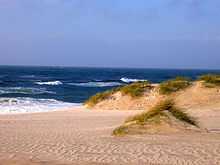






.jpg)
 Media related to Tourism in Germany at Wikimedia Commons
Media related to Tourism in Germany at Wikimedia Commons

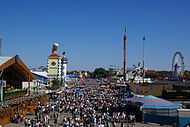


.jpg)








